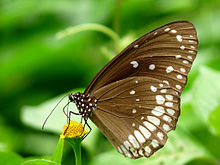Euploea core
| Common crow | |
|---|---|
 |
|
| Scientific classification | |
| Kingdom: | Animalia |
| Phylum: | Arthropoda |
| Class: | Insecta |
| Order: | Lepidoptera |
| Family: | Nymphalidae |
| Genus: | Euploea |
| Species: | E. core |
| Binomial name | |
|
Euploea core (Cramer, 1780) |
|
 |
|
Euploea core, the common crow, is a common butterfly found in South Asia and Australia. In India it is also sometimes referred to as the common Indian crow, and in Australia as the Australian crow. It belongs to the crows and tigers subfamily Danainae (Danaini tribe).
E. core is a glossy-black, medium-sized 85–95 millimetres (3.3–3.7 in) butterfly with rows of white spots on the margins of its wings. E. core is a slow, steady flier. Due to its unpalatability it is usually observed gliding through the air with a minimum of effort. As caterpillars, this species sequesters toxins from its food plant which are passed on from larva to pupa to the adult. While feeding, it is a very bold butterfly, taking a long time at each bunch of flowers. It can also be found mud-puddling with others of its species and often in mixed groups. The males of this species visit plants like Crotalaria and Heliotropium to replenish pheromone stocks which are used to attract a mate during courtship.
The common crow is the most common representative of its genus Euploea. Like the tigers (genus Danaus), the crows are inedible and thus mimicked by other Indian butterflies (see Batesian mimicry). In addition, the Indian species of the Euploea genus shows another kind of mimicry, Müllerian mimicry. Accordingly, this species has been studied in greater detail than other members of its genus in India.
The common crow is a glossy-black butterfly with brown undersides with white markings along the outer margins of both wings. The wingspan is about 8–9 cm and the body has prominent white spots. The male has a velvety black brand located near the rear edge on the upperside of the forewing. On the underside there is a white streak in the same location. This white streak is present in both male and female. In its natural position this streak is hidden behind the hindwing and can be seen only when the butterfly is captured and observed closely.
Excerpt from Fauna of British India: Butterflies, volume 1:
Upperside dark brown, broadly paler along terminal margins; Fore and hind wing with subterminal and terminal series of white spots; on fore wing the former more or less oval, curved inwards opposite apex, the latter series often incomplete, not reaching apex, the spots smaller; often there is a small costal spot, and very rarely a spot in apex of cell and one or more discal spots; on the hind wing the inner series of spots are elongate, the outer conical.
Underside similar, but ground-colour more uniform; cell, costal and discal spots on both fore and hind wing nearly always present.
Race godarti (=E. godarti) (Northeast India and Myanmar) Fore wing subtriangular, tornus more rounded than in E. core. Hindwing broadly ovate. Upperside dark brown, broadly paler along the terminal margins, especially on the fore wing. Fore wing with more or less incomplete and obsolescent series of subterminal and terminal small white spots, and a powdering of violaceous-white scales at apex, varying very considerably in extent from a mere trace of violaceous between the veins to a large and very conspicuous patch occupying the whole of the apex. Hind wing with a subterminal series of oval or inwardly conical and terminal series of more rounded white spots.
Underside paler brown, the white spots larger, more clearly defined. Fore wing not violaceous at apex, a spot (sometimes absent) in apex of cell, and two or three discal spots. Hindwing: a spot in apex of cell, also sometimes absent, and a discal series of five small spots beyond. Antennae, head, thorax and abdomen very dark brown, and, the antennae excepted, sparsely spotted with white.
...
Wikipedia

